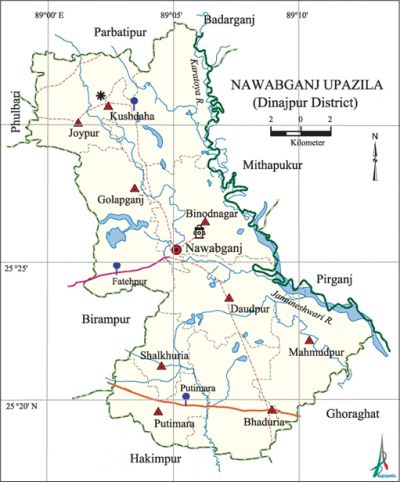Nawabganj Upazila (Dinajpur District)
Nawabganj Upazila (dinajpur district) area 314.68 sq km, located in between 25°14' and 25°34' north latitudes and in between 88°58' and 89°13' east longitudes. It is bounded by parbatipur upazila on the north, ghoraghat and hakimpur upazilas on the south, pirganj (rangpur), mithapukur and badarganj upazilas on the east, birampur and phulbari upazilas on the west.
Population Total 204351; male 105259, female 99092; Muslim 179973, Hindu 14399, Buddhist 3208, Christian 315 and others 6456. Indigenous communities such as santal, oraon and munda belong to this upazila.
Water bodies Main rivers: karatoya, Jamuneshwari.
Administration Nawabganj Thana was formed in 1899 and it was turned into an upazila in 1983.
| Upazila | ||||||||
| Municipality | Union | Mouza | Village | Population | Density (per sq km) | Literacy rate (%) | ||
| Urban | Rural | Urban | Rural | |||||
|
- |
9 |
212 |
282 |
5827 |
198524 |
649 |
58.1 |
37.8 |
| Upazila Town | ||||||||
|
Area (sq km) |
Mouza |
Population |
Density (per sq km) |
Literacy rate (%) | ||||
|
3.48 |
4 |
5827 |
1674 |
58.1 | ||||
| Union | ||||
| Name of union and GO code | Area (acre) | Population | Literacy rate (%) | |
| Male | Female | |||
|
Kushdaha 69 |
11008 |
13208 |
12155 |
36.22 |
|
Golapganj 43 |
10752 |
13545 |
13073 |
33.45 |
|
Joypur 51 |
8895 |
10210 |
9535 |
35.11 |
|
Daudpur 25 |
8842 |
13483 |
12798 |
42.87 |
|
Putimara 86 |
5556 |
8584 |
7886 |
36.57 |
|
Binodnagar 17 |
10034 |
16260 |
14898 |
40.92 |
|
Bhaduria 8 |
9418 |
11878 |
11275 |
41.82 |
|
Mahmudpur 77 |
9330 |
12739 |
11958 |
36.59 |
|
Shalkhuria 94 |
3924 |
5652 |
5514 |
43.39 |
Source Bangladesh Population Census 2001, Bangladesh Bureau of Statistics.

Archaeological heritage and relics Holaijana Ancient Mosque, Setakot Vihara, Kanjir Hari and Aruna Dhap, Jigagarh and Harinathpur Fort.
History of the War of Liberation On 20 July 1971, the Pak army brutally killed 21 innocent persons of village Khayergani. Besides, they also killed 157 innocent people at Chararhat of the upazila on 10 October.
Marks of the War of Liberation Mass grave 1 (Chararhat).
Religious institutions Mosque 35, temple 17, church 8, math 3. Noted religious institutions: Holaijana Mosque, Tarpanghat Mandir, Kali Mandir.
Literacy rate and educational institutions Average literacy 38.4%; male 43.2%, female 33.5%. Educational institutions: college 11, secondary school 67, primary school 134, madrasa 39. Noted educational institutions: Daudpur Degree College (1972), Nawabganj Degree College (1987), Aftabganj Degree College (1994), Palashbari High School (1921), Daudpur Bilateral High School (1939), Binodnagar High School (1960), Aftabganj High School (1964), Hatishal Dishbandi Fazil Madrasa (1954), Kanchdaha Senior Madrasa (1956), Deoga Senior Madrasa (1959).
Newspapers and periodicals Defunct: Darpan, Ayna, Tarunna, Sapnapuri, Nabachetana.Cultural organisations Club 46, cinema hall 3.
Amusement centres Sapnapuri.
Main sources of income Agriculture 75.28%, non-agricultural labourer 2.92%, industry 0.44%, commerce 9.51%, transport and communication 2.15%, service 4.03%, construction 0.53%, religious service 0.15%, rent and remittance 0.07% and others 4.92%.
Ownership of agricultural land Landowner 59.73%, landless 40.27%; agricultural landowner: urban 49.01% and rural 60.04%.
Main crops Paddy, wheat, jute, maize, pulse, oil seed, sugarcane, potato, vegetables.
Extinct or nearly extinct crops Sesame, linseed, kaun.
Main fruits Mango, banana, jackfruit, litchi.
Fisheries, dairies and poultries Poultry 4.
Communication facilities Pucca road 149 km, semi-pucca road 20 km, mud road 535 km.
Extinct or nearly extinct traditional transport Palanquin, bullock cart, horse carriage.
Noted manufactories Rice mill, auto rice mill, saw mill, lathe machine, ice factory, biscuit factory.
Cottage industries Goldsmith, blacksmith, potteries.
Hats, bazars and fairs Hats and bazars are 26, fairs 5, most noted of which are Daudpur Hat, Nawabganj Hat, Bhaduria Hat, Binodnagar Hat, Daria Hat, Aftabganj Hat, Tarpanghat Mela, Bura Shib Mela, Kali Mela.
Main exports Paddy, jute, sugarcane, molasses.
Access to electricity All the unions of the upazila are under rural electrification net-work. However 17.53% of the dwelling households have access to electricity.
Natural resources High quality coal and minarals have been detected at Dighipara of this upazila.
Sources of drinking water Tube-well 89.95%, pond 0.60%, tap 0.36% and others 9.09%.
Sanitation 11.10% (rural 10.60% and urban 28.21%) of dwelling households of the upazila use sanitary latrines and 27.33% (rural 26.83% and urban 44.42%) of dwelling households use non-sanitary latrines; 61.57% of households do not have latrine facilities.
Health centres Upazila health centre 1, union health and family welfare centre 9.
Natural disasters Many people were victims of starvation due to the famine of 1943. Besides, the floods of 1987 and 1991 caused heavy damages to the settlements, crops and other properties on the bank of the Karatoya.
NGO activities Operationally important NGOs are brac, asa, caritas, thengamara mahila sabuj sangha. [SM Mahfuzur Rahman]
References Bangladesh Population Census 2001, Bangladesh Bureau of Statistics; Cultural survey report of Nawabganj Upazila 2007.
